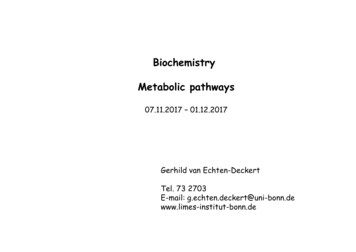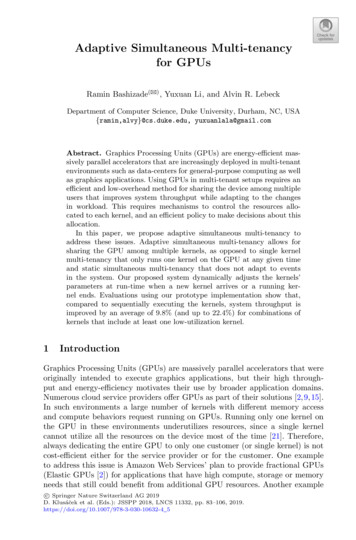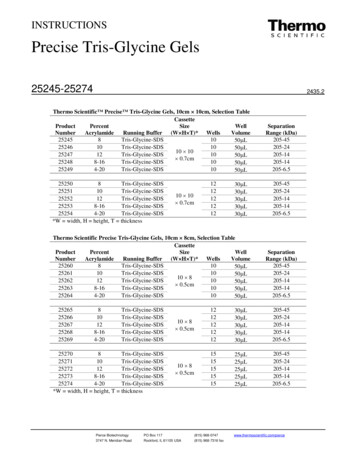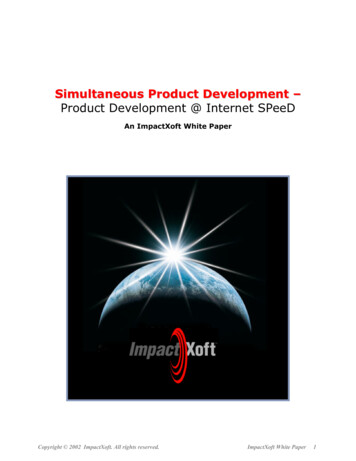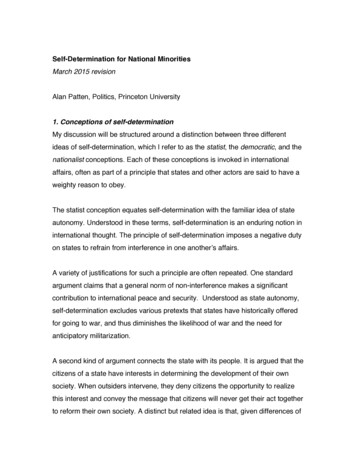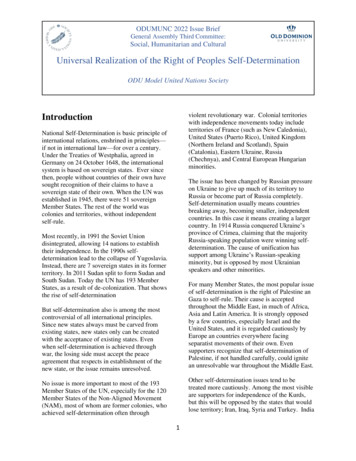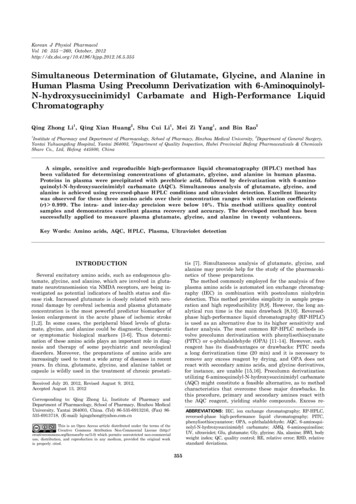
Transcription
Korean J Physiol PharmacolVol 16: 355-360, October, multaneous Determination of Glutamate, Glycine, and Alanine inHuman Plasma Using Precolumn Derivatization with 6-AminoquinolylN-hydroxysuccinimidyl Carbamate and High-Performance LiquidChromatographyQing Zhong Li1, Qing Xian Huang2, Shu Cui Li1, Mei Zi Yang1, and Bin Rao31Institute of Pharmacy and Department of Pharmacology, School of Pharmacy, Binzhou Medical University, 2Department of General Surgery,3Yantai Yuhuangding Hospital, Yantai 264003, Department of Quality Inspection, Hubei Provincial Bafeng Pharmaceuticals & ChemicalsShare Co., Ltd, Hefeng 445800, ChinaA simple, sensitive and reproducible high-performance liquid chromatography (HPLC) method hasbeen validated for determining concentrations of glutamate, glycine, and alanine in human plasma.Proteins in plasma were precipitated with perchloric acid, followed by derivatization with 6-aminoquinolyl-N-hydroxysuccinimidyl carbamate (AQC). Simultaneous analysis of glutamate, glycine, andalanine is achieved using reversed-phase HPLC conditions and ultraviolet detection. Excellent linearitywas observed for these three amino acids over their concentration ranges with correlation coefficients(r) 0.999. The intra- and inter-day precision were below 10% . This method utilizes quality controlsamples and demonstrates excellent plasma recovery and accuracy. The developed method has beensuccessfully applied to measure plasma glutamate, glycine, and alanine in twenty volunteers.Key Words: Amino acids, AQC, HPLC, Plasma, Ultraviolet detectionINTRODUCTIONtis [7]. Simultaneous analysis of glutamate, glycine, andalanine may provide help for the study of the pharmacokinetics of these preparations.The method commonly employed for the analysis of freeplasma amino acids is automated ion exchange chromatography (IEC) in combination with postcolumn ninhydrindetection. This method provides simplicity in sample preparation and high reproducibility [8,9]. However, the long analytical run time is the main drawback [8,10]. Reversedphase high-performance liquid chromatography (RP-HPLC)is used as an alternative due to its higher sensitivity andfaster analysis. The most common RP-HPLC methods involve precolumn derivatization with phenylisothiocyanate(PITC) or o-phthalaldehyde (OPA) [11-14]. However, eachreagent has its disadvantages or drawbacks: PITC needsa long derivatization time (20 min) and it is necessary toremove any excess reagent by drying, and OPA does notreact with secondary amino acids, and glycine derivatives,for instance, are unable [15,16]. Precolumn derivatizationutilizing 6-aminoquinolyl-N-hydroxysuccinimidyl carbamate(AQC) might constitute a feasible alternative, as to methodcharacteristics that overcome these major drawbacks. Inthis procedure, primary and secondary amines react withthe AQC reagent, yielding stable compounds. Excess re-Several excitatory amino acids, such as endogenous glutamate, glycine, and alanine, which are involved in glutamate neurotransmission via NMDA receptors, are being investigated as potential indicators of health status and disease risk. Increased glutamate is closely related with neuronal damage by cerebral ischemia and plasma glutamateconcentration is the most powerful predictor biomarker oflesion enlargement in the acute phase of ischemic stroke[1,2]. In some cases, the peripheral blood levels of glutamate, glycine, and alanine could be diagnostic, therapeuticor symptomatic biological markers [3-6]. Thus determination of these amino acids plays an important role in diagnosis and therapy of some psychiatric and neurologicaldisorders. Moreover, the preparations of amino acids areincreasingly used to treat a wide array of diseases in recentyears. In china, glutamate, glycine, and alanine tablet orcapsule is wildly used in the treatment of chronic prostatiReceived July 20, 2012, Revised August 9, 2012,Accepted August 13, 2012Corresponding to: Qing Zhong Li, Institute of Pharmacy andDepartment of Pharmacology, School of Pharmacy, Binzhou MedicalUniversity, Yantai 264003, China. (Tel) 86-535-6913216, (Fax) 86535-6913718, (E-mail) lqingzhong@yahoo.com.cnABBREVIATIONS: IEC, ion exchange chromatography; RP-HPLC,reversed-phase high-performance liquid chromatography; PITC,phenylisothiocyanateor; OPA, o-phthalaldehyde; AQC, 6-aminoquinolyl-N-hydroxysuccinimidyl carbamate; AMQ, 6-aminoquinoline;UV, ultraviolet; Glu, glutamate; Gly, glycine; Ala, alanine; BWI, bodyweight index; QC, quality control; RE, relative error; RSD, relativestandard deviations.This is an Open Access article distributed under the terms of theCreative Commons Attribution Non-Commercial License (http://creativecommons.org/licenses/by-nc/3.0) which permits unrestricted non-commercialuse, distribution, and reproduction in any medium, provided the original workis properly cited.355
356QZ Li, et alagent is hydrolyzed to yield 6-aminoquinoline (AMQ), carbon dioxide and N-hydroxysuccinimide [17]. The advantagesof this method include a very simple derivatization procedure, stable derivatives, excellent separation, detection byeither absorbance or fluorescence, and commercial availability of reagents. Disadvantages include relatively longchromatography, high solvent consumption and no possibility of on-line derivatization, which seems limited compared to the defects of other methods.In the present study, we describe a sensitive and rapidRP-HPLC method, using AQC derivatization and ultraviolet (UV) detection. The objective is to obtain a simpleand rapid simultaneous measurement of glutamate, glycine, and alanine in human plasma.METHODSChemicalsAccQ.Fluor reagent kit (consisting of AQC reagent, acetonitrile and 0.2 mM sodium borate buffer, pH 8.8) as wellas glass reaction tubes (6 50 mm) were provided by Waters(Milford, MA, USA). Amino acid standards (glutamate: Glu,glycine: Gly, alanine: Ala) were obtained from Sigma (StLouis, MO, USA). HPLC grade acetonitrile and triethylamine were from Merck (Darmstadt, Germany). Perchloricacid and sodium acetate were of analytical reagent gradeand purchased from J.T. Baker (Phillipsburg, NJ, USA).Ultrapure water was generated using a Milli-Q system purchased from Millipore (Bedford, MA, USA).Chromatographic instruments and conditionsThe HPLC system used was a Waters Alliance consistingof a 2,690 separation model, a thermostat-controlled column oven, a system interface module, and a 2,487 DualWavelength UV Detector (all Waters components, Millipore,Milford, MA, USA). A Millennium Chromatography Manager workstation running Millennium software controls system operation and results management. Separation wascarried out using a 20 3.9 mm Sentry guard column (NovaPak C18 bonded silica) connected to a 4 μm AccQ-Tag C18column (3.9 150 mm I.D.; both from Waters).Working eluentsEluent A was 0.14 M sodium acetate with 0.017 M triethanolamine (pH 4.95); eluent B was 60% (v/v) acetonitrileTable 1. Optimized gradient for the separation of amino acidsoat 37 CTime (min)013599.112%A%Bsodium acetate 60% 1111*Curve 6 is a linear segment; curve 11 is a step function.aqueous solution. The gradient program is shown in Table1.oThe AccQ-Tag column was thermostated at 37 C and operated at a flow-rate of 1 ml/min. Detection was accomplished by UV detector and the wavelength was set at 248nm. For column regeneration, 3 min with 60% acetonitrileand 40% water was sufficient to wash out the column andbefore the next injection, 100% sodium acetate for 6 minwas needed to equilibrate the system. Injections were madeevery 18 min (injection-to-injection), using an injection volume of 10 μl.Standard solutionsStock solutions of Glu, Gly, and Ala needed in the methodwere prepared by dissolving appropriate amount of thecompounds in 0.1 M hydrochloric acid and diluting to theoappropriate volumes. These solutions were kept at 4 C forseveral days without noticeable change. The working solutions were prepared by appropriate dilutions with wateras needed, and processed without delay.Plasma preparationTwenty healthy male volunteers were recruited for thisstudy. They are 19 25 years old with BWI (body weight2index) between 19 24 kg/m . The study was performed inaccordance with the Helsinki Declaration and the designand execution of the experiment were explained thoroughlyto the participants, and informed consent was obtained.Blood was collected, following an overnight fast, intoevacuated lithium heparin gel tubes, immediately placedoon ice, and centrifuged at 3,000 rpm for 15 min at 4 C.Plasma was then used for the determination of Glu, Gly,oand Ala without delay or stored at -70 C. Prior to analysis,a 100 μl portion of the plasma sample was added to 100μl of 5% perchloric acid, and the solution was mixed witha vortex-mixer. After vortex-mixing, the precipitate was reomoved by centrifugation at 15,000 rpm for 10 min at 4 Cand the supernatant was used for the analysis.Quality control (QC) samples preparationFor validation of the method, QC samples were made byadding the appropriate amount of working standard solution of Glu, Gly, and Ala to the plasma samples from anapparently healthy donor. The nominal concentrations oflow, medium, and high QC samples were 40, 80, 160 μMfor Glu; 160, 400, 640 μM for Gly and 200, 500, 800 μMfor Ala, respectively.DerivatizationIn a typical analysis, 10 μl of standards or samples weremixed with 70 μl buffer solution (0.2 M borate buffer) andafterwards 20 μl derivatization reagent (2 mg/ml AQC)owere added. After ten minutes response at 55 C, the derivatized solution was directly injected to separate the aminoacids by HPLC.Calibration and linearityThe retention time of each amino acid was studied usingdilutions from stock solutions. Linearity was assured bycalculating the regression coefficients for the calibration
HPLC Method for Determination of Amino Acidscurves. Range of the analysis was determined by assuringthat all the points on the calibration curve were characterised by acceptable precision and accuracy. For eachcurve, the peak area were calculated and plotted againstconcentration of the corresponding amino acid.Precision and accuracyPrecision and accuracy were determined by the analysisof QC samples spiked at three concentrations listed above.The intra-assay was determined by replicate analysis of ablank (unspiked) plasma sample (n 6) and a QC sampleat each concentration (n 6) in a single run. The inter-assaywas determined by replicate analysis of the same QC samople stored at -70 C and analyzed 6 separate times overa period of 2 months. The calculated mean concentrationrelative to the nominal concentration (relative error: RE%)was used to express accuracy and relative standard deviations (RSD%) calculated from the blank sample and QC values was used to estimate the inter- and intra-day precision.Recovery and stability357by analyzing pooled human plasma obtained from a healthyvolunteer spiked at the three QC concentration levels listedabove. Six replicate ‘control’ (unspiked) plasma samplesand six spiked samples of each QC level were analyzed andrecovery was determined by comparing the nominal aminoacid concentration. The recovery of each amino acid wasdefined as 100%. Means, standard deviations (SD) andRSD% were calculated.oThe stability of plasma samples stored at -70 C within2 months was assessed. Also, QC samples were subjectedoto three freeze-thaw cycles (-70 C to room temperature)to evaluate sample stability. In addition, stability of processed samples was assessed. Triplicate low and high QCsamples were processed and analyzed, then re-injected andanalyzed up to 24 h post-processing.Application to determination of Glu, Gly, and Ala inhuman plasmaAfter the full validation, this method was successfully applied to the determination of Glu, Gly, and Ala in plasmafrom twenty male volunteers.Recovery of Glu, Gly, and Ala from plasma was assessedFig. 1. Typical chromatograms of Glu, Gly, and Ala in plasma. (A) Chromatogram for derivatized blank; (B) chromatography for derivatizedamino acid standard mixture; (C) representative chromatography of blank (unspiked) pooled human plasma sample; (D) chromatographyof the high QC sample (spiked concentrations of Glu, Gly, and Ala were 160, 640, and 800 μM, respectively).
358QZ Li, et alRESULTSStability and recoveryChromatographic separationThe plasma samples were stable for up to 2 months ato-70 C. Three freeze-thaw cycles had no effect on the stability of Glu, Gly, and Ala. Additionally, amino acid derivatives are stable at room temperature for 24 hours. The meanrecoveries of all analytes from plasma at all concentrationsranged from 95% to 103%. At the same time, the RSD%values were less than 5% which showed significant inverserelationship with the concentration of the analyte (Table3).Representative chromatograms of the derivatized blank,standard solution, blank (unspiked) plasma sample and QCplasma sample are depicted in Fig. 1. The method demonstrated good chromatographic separation of all the aminoacids studied, and showed an excellent signal-to-noise ratio,allowing easy quantification. Retention times for Glu, Gly,and Ala were approximately 6.3, 7.9, and 9.3 min, respectively. The peaks of interest were well separated and therewas no interference from other amino acids and endogenouscompounds in plasma.Analysis of human plasma samplesLinearity, precision and accuracyThe method described in this paper was applied for amino acid analysis in plasma samples from twenty male volunteers (Table 4). Free plasma amino acids exhibit widevariability between subjects. This probably reflects differences in metabolic control since the amino acids belong toendogenous substances which can be influenced by physiologic conditions of different volunteers as well as diet.Plasma concentrations of Glu, Gly, and Ala were 51.7 16.5,289.7 46.5, and 350.1 59.9 μM, respectively.Linear calibration curves were obtained for Glu, Gly, andAla over the concentration ranges of 5 320 μM, 18.75 1,200 μM, and 21.9 1400 μM, respectively. The mean regression equations were y 1,414.2x 1791.3 for Glu, y 1,590.7x 6,982.6 for Gly, and y 1,626.6x 7289.2 for Ala,with correlation coefficients (r) 0.999 for all three aminoacids. The lower limit of quantitation (LOQ) for each aminoacid demonstrated acceptable precision.The intra- and inter-day RSD% were between 1.8% and9.5% and most RSD% values calculated from the high QCsamples of each amino acid were smaller than those fromlow and medium QC samples especially pronounced in Alagroup. The accuracy, expressed as RE%, was within 10%(Table 2).DISCUSSIONThe increasing significance of plasma concentrations ofGlu, Gly, and Ala in clinical fields, such as being used asdiagnostic or therapeutic biomarkers, has prompted theTable 2. Intra- and inter-day precision and accuracy for Glu, Gly, and Ala (n .74.1Blank sampleLow QC sampleMedium QC sampleHigh QC %-5.0-4.3-7.1Table 3. Recovery rate (%) of Glu, Gly, and Ala from human plasma (n 6)GluLow QC sampleMedium QC sampleHigh QC sampleGlyAlaMean SD (%)RSD%Mean SD (%)RSD%Mean SD (%)RSD%99.0 3.496.3 1.795.1 0.93.51.80.9102.1 2.8103.4 2.6103.3 2.52.82.52.4102.7 3.4100.5 1.298.5 1.23.31.21.1Table 4. Plasma concentrations of Glu, Gly, and Ala from 20 healthy volunteersAminoacidsGluGlyAlaPlasma concentration (μM) in 20 volunteers (No.1 20)1234567891011121314151617181920Mean SD(μM)62.7 91.0 26.7 82.1 56.1 56.7 35.4 86.4 36.2 62.4 72.5 50.3 35.3 35.1 46.2 41.2 32.0 30.3 34.5 60.9 51.7 16.5282.3 286.1 188.4 262.7 302.5 297.6 271.9 295.8 297.8 318.6 428.6 236.4 344.8 353.8 291.0 328.0 186.3 248.8 179.4 393.5 289.7 46.5395.7 445.5 202.6 334.4 417.9 322.4 289.5 462.8 264.7 384.8 356.1 418.1 220.4 431.9 349.8 354.5 314.2 322.3 282.2 432.5 350.1 59.9
359HPLC Method for Determination of Amino Acidsstudy of these amino acids analyses. In this study, we intended to develop a method of simultaneous determinationof Glu, Gly, and Ala in plasma which would be highly accurate, but at the same time not so time-consuming. Thismethod is based on the use of precolumn AQC derivatization as well as the optimized mobile phase and gradientfor the separation. In addition, the sensitivity, linearity anddetection limits of these amino acids by using UV detectorwere assessed strictly. The second step is method validation, which verifies the performance of the entire analytical process. Finally, plasma Glu, Gly, and Ala were determined using this method, and the concentrations ofthese amino acids were generally consistent with those reported in other studies [18,19].As developed by the Waters Co., Ltd, the mobile phaseused in the traditional AQC method [17] has been modifiedby increasing the proportion of eluent B (60% acetonitrile)while decrease the gradient time. The optimized gradient(Table 1) accelerated the separation of Glu, Gly, and Ala,which therefore shortened the time required for assay andthe total run time is only about 18 min.The other critical step in the whole procedure is samplepreparation including the sample collection, storage anddeproteinization. When deprotenization of the plasma samples cannot be done immediately after centrifugation, it isrecommended to store the samples at temperatures lowerothan -18 C to prevent further hydrolysis of proteins.Previous studies demonstrated that the Glu increased marokedly when the storage temperature higher than -68 C,so the plasma samples were frozen immediately and storedat -70oC until analyzed in this study, and all the studiedamino acids remained stable within 8 weeks. Another pointregarding deproteinization should be emphasized as well.The most wildly used methods for deproteinization of plasma samples include precipitation with acids or organicsolvents. In our experiment, we tried acetonitrile, 5-sulfosalicylic acid, and perchloric acid for the deproteinization ofplasma samples and compared the efficacy of them. Wefound that the concentrations of Glu and Gly using acetonitril, were lower than those measured with 5-sulfosalicylicacid and perchloric acid. Also, we observed that perchloricacid protein precipitation was superior to 5-sulfosalicylicacid because 5-sulfosalicylic acid interfered with the chromatography of Glu peaks, which was consistent with a previous report [20]. For this reason, perchloric acid was usedas the deproteinizing reagent in this analysis.Our modified method has been successfully validated.The mobile phase conditions produce excellent separationof Glu, Gly, and Ala in plasma (Fig. 1) with good sensitivity,i.e. lower LOQ for all analytes. After deproteinization with5% perchloric acid, perfect recovery (95% to 103%; Table3) of all analytes from plasma was achieved. Another important characteristic of the method is high precision. Theexperimental results abstained from the intra- and inter-day precision and accuracy (Table 2) showed that RSD%values of these three amino acids were below 10%.Meanwhile, most RSD% values of high QC samples weresmaller than those of low and medium QC samples, andsimilar results are also shown in Table 3. Precision relatesto the random error of a measurement system and the obvious relationship between the precision of an analyticalmethod and the concentration of the analyte was usuallyobserved in many studies. The results of our study alsodemonstrated that smaller RSD%, which indicates higherprecision, was achieved when the high QC samples wereanalyzed.In summary, the method described here, using a precolumn derivatization with AQC, is a rapid, sensitive, andselective technique for simultaneously analyzing Glu, Gly,and Ala in human plasma. The chromatographic conditionsallow for the separation and quantification of amino acidsusing a simplified gradient. This assay shows good precision and reproducibility, and it is a relatively simple andfast method. Finally, this method was used to determineGlu, Gly, and Ala in the plasma of twenty healthy humanvolunteers.ACKNOWLEDGEMENTSWe would like to thank Dr. Ki-Wug Sung from theCatholic University of Korea for his kind and valuablesuggestions.REFERENCES1. Lee GJ, Choi SK, Eo YH, Kang SW, Choi S, Park JH, LimJE, Hong KW, Jin HS, Oh BS, Park HK. The effect ofextracellular glutamate release on repetitive transientischemic injury in global ischemia model. Korean J PhysiolPharmacol. 2009;13:23-26.2. Castellanos M, Sobrino T, Pedraza S, Moldes O, Pumar JM,Silva Y, Serena J, García-Gil M, Castillo J, Dávalos A. Highplasma glutamate concentrations are associated with infarctgrowth in acute ischemic stroke. Neurology. 2008;71:1862-1868.3. Mitani H, Shirayama Y, Yamada T, Maeda K, Ashby CR Jr,Kawahara R. Correlation between plasma levels of glutamate,alanine and serine with severity of depression. Prog Neuropsychopharmacol Biol Psychiatry. 2006;30:1155-1158.4. Andreadou E, Kapaki E, Kokotis P, Paraskevas GP, KatsarosN, Libitaki G, Petropoulou O, Zis V, Sfagos C, VassilopoulosD. Plasma glutamate and glycine levels in patients withamyotrophic lateral sclerosis. In Vivo. 2008;22:137-141.5. Wesseldijk F, Fekkes D, Huygen FJ, van de Heide-Mulder M,Zijlstra FJ. Increased plasma glutamate, glycine, and argininelevels in complex regional pain syndrome type 1. ActaAnaesthesiol Scand. 2008;52:688-694.6. Ohnuma T, Arai H. Significance of NMDA receptor-relatedglutamatergic amino acid levels in peripheral blood of patientswith schizophrenia. Prog Neuropsychopharmacol Biol Psychiatry. 2011;35:29-39.7. Zhao JL. Clinical therapeutic effects of sparfloxacin andglutamic acid, alanine acid and glycine acid capsules in thetreatment of chronic prostatis. Chin Clin Prac Med. 2007;1:3335.8. Fekkes D. State-of-the-art of high-performance liquid chromatographic analysis of amino acids in physiological samples. JChromatogr B Biomed Appl. 1996;682:3-22.9. Le Boucher J, Charret C, Coudray-Lucas C, Giboudeau J,Cynober L. Amino acid determination in biological fluids byautomated ion-exchange chromatography: performance ofHitachi L-8500A. Clin Chem. 1997;43:1421-1428.10. Fekkes D, Voskuilen-Kooyman A, Jankie R, Huijmans J.Precise analysis of primary amino acids in urine by anautomated high-performance liquid chromatography method:comparison with ion-exchange chromatography. J ChromatogrB Biomed Sci Appl. 2000;744:183-188.11. Turnell DC, Cooper JD. Rapid assay for amino acids in serumor urine by pre-column derivatization and reversed-phaseliquid chromatography. Clin Chem. 1982;28:527-531.12. Heinrikson RL, Meredith SC. Amino acid analysis by reversephase high-performance liquid chromatography: precolumn derivatization with phenylisothiocyanate. Anal Biochem. 1984;136:65-74.
360QZ Li, et al13. Anumula KR, Taylor PB. Quantitative determination of phenylisothiocyanate-derivatized amino sugars and amino sugaralcohols by high-performance liquid chromatography. AnalBiochem. 1991;197:113-120.14. Kutlán D, Presits P, Molnár-Perl I. Behavior and characteristics of amine derivatives obtained with o-phthaldialdehyde/3-mercaptopropionic acid and with o-phthaldialdehyde/N-acetyl-L-cysteine reagents. J Chromatogr A. 2002;949:235248.15. Bosch L, Alegría A, Farré R. Application of the 6-aminoquinolyl-N-hydroxysccinimidyl carbamate (AQC) reagent to theRP-HPLC determination of amino acids in infant foods. JChromatogr B Analyt Technol Biomed Life Sci. 2006;831:176-183.16. Cohen SA. Amino acid analysis using precolumn derivatizationwith 6-aminoquinolyl-N-hydroxysuccinimidyl carbamate. MethodsMol Biol. 2000;159:39-47.17. Cohen SA, Michaud DP. Synthesis of a fluorescent derivatizingreagent, 6-aminoquinolyl-N-hydroxysuccinimidyl carbamate,and its application for the analysis of hydrolysate amino acidsvia high-performance liquid chromatography. Anal Biochem.1993;211:279-287.18. Terrlink T, van Leeuwen PA, Houdijk A. Plasma amino acidsdetermined by liquid chromatography within 17 minutes. ClinChem. 1994;40:245-249.19. Chih-Kuang C, Shuan-Pei L, Shyue-Jye L, Tuan-Jen W. Plasmafree amino acids in Taiwan Chinese: the effect of age. ClinChem Lab Med. 2002;40:378-382.20. Frank MP, Powers RW. Simple and rapid quantitativehigh-performance liquid chromatographic analysis of plasmaamino acids. J Chromatogr B Analyt Technol Biomed Life Sci.2007;852:646-649.
(PITC) or o-phthalaldehyde (OPA) [11-14]. However, each reagent has its disadvantages or drawbacks: PITC needs a long derivatization time (20 min) and it is necessary to remove any excess reagent by drying, and OPA does not react with secondary amino acids, and glycine derivatives, for instance, are unable [15,16]. Precolumn derivatization

